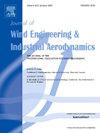45 m跨双层索支阵列光伏结构风致响应试验研究
IF 4.9
2区 工程技术
Q1 ENGINEERING, CIVIL
Journal of Wind Engineering and Industrial Aerodynamics
Pub Date : 2025-09-01
DOI:10.1016/j.jweia.2025.106213
引用次数: 0
摘要
电缆支撑的光伏(PV)结构由于其低频率和轻量化而极易受到风致振动的影响。为了研究45m跨度双层索支光伏阵列结构在大气边界层中的风效应,采用1:20比例气动弹性模型进行风洞试验,测量风致响应。研究了斜度、风向和风速对索撑光伏结构风致响应的影响。试验结果表明,负迎角条件下的风致响应显著大于正迎角条件下的风致响应。当承受负AOA时,结构更容易失稳。在正AOA条件下,观察到明显的屏蔽效应。当倾角为10°和20°时,屏蔽比最大值分别为21.28%和51.18%。提出的风振系数为2.1,可用于计算结构设计中双层索撑PV结构的等效静风荷载。本文章由计算机程序翻译,如有差异,请以英文原文为准。
Experimental study on wind-induced response on a 45 m span double-layer cable-supported photovoltaic structure with arrays
Cable-supported photovoltaic (PV) structures are highly susceptible to wind-induced vibrations because of their low frequency and lightweight. To investigate the wind effect of a 45m-span double-layer cable-supported PV array structure in an atmospheric boundary layer, wind tunnel tests on a 1:20 scale aeroelastic model were conducted to measure wind-induced responses. The influences of tilt angle, wind direction, and wind speed on the wind-induced response of cable-supported PV structure are examined. The test results indicate that the wind-induced response under negative angle of attack (AOA) is significantly greater than those under positive AOA. When subjected to negative AOA, the structure is more likely to be instability. Under positive AOA, a significant shielding effect is observed. The maximum value of shielding ratio for tilt angles of 10° and 20° are 21.28 % and 51.18 %, respectively. The proposed wind vibration coefficient is 2.1, which can be used to calculate the equivalent static wind load of the double-layer cable-supported PV structure in structural design.
求助全文
通过发布文献求助,成功后即可免费获取论文全文。
去求助
来源期刊
CiteScore
8.90
自引率
22.90%
发文量
306
审稿时长
4.4 months
期刊介绍:
The objective of the journal is to provide a means for the publication and interchange of information, on an international basis, on all those aspects of wind engineering that are included in the activities of the International Association for Wind Engineering http://www.iawe.org/. These are: social and economic impact of wind effects; wind characteristics and structure, local wind environments, wind loads and structural response, diffusion, pollutant dispersion and matter transport, wind effects on building heat loss and ventilation, wind effects on transport systems, aerodynamic aspects of wind energy generation, and codification of wind effects.
Papers on these subjects describing full-scale measurements, wind-tunnel simulation studies, computational or theoretical methods are published, as well as papers dealing with the development of techniques and apparatus for wind engineering experiments.

 求助内容:
求助内容: 应助结果提醒方式:
应助结果提醒方式:


